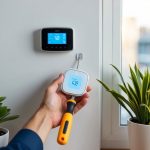Hydroponic Garden Kits: Grow Fresh Herbs Indoors Year-Round
Innovations in Hydroponics: Smart Gardens
Smart gardens are transforming indoor hydroponic gardening by integrating technology for enhanced efficiency and ease of use. These systems offer features such as automated watering and lighting, adapting to the needs of each plant. The advancements allow users to manage their gardens effortlessly, ensuring optimal growth conditions throughout the year.
The Convenience of Automated Systems
One of the key innovations in smart gardens is the use of automated systems that handle essential tasks. These systems can regulate light and water levels, ensuring plants receive the right amount at the right time. By continuously monitoring conditions, smart gardens can adjust settings to provide ideal growing conditions, reducing the need for manual intervention. Automated systems also help conserve resources, with sensors that detect when less water is needed, making the process both convenient and efficient.
Smart gardens use IoT devices that allow remote monitoring through mobile apps. Users can receive notifications about their plants’ needs and make necessary adjustments even when not at home. This aspect of convenience appeals to both busy individuals and novices, as it removes the guesswork and labor traditionally associated with gardening.
Smart Garden Features and Capabilities
Smart gardens come equipped with advanced features such as self-watering mechanisms and energy-efficient LED lighting. These features significantly contribute to the self-sufficiency of the garden. With self-watering capabilities, the system monitors soil moisture levels and waters the plants as needed, preventing overwatering and under-watering. This ensures that plants remain healthy and vibrant.
LED lights provide plants with the specific light spectrum they need to grow, which can be adjusted based on the plant’s growth stage. Some smart gardens even include voice-controlled systems, offering an added layer of convenience for users. All these features ensure that anyone can maintain a thriving indoor garden with minimal effort.
Maintaining Your Hydroponic Garden
Keeping a hydroponic setup thriving requires regular attention to detail and the ability to address challenges as they arise. Consistent maintenance routines and effective troubleshooting will ensure a productive and healthy garden environment year-round.
Daily and Weekly Maintenance Routines
Daily checks are crucial for monitoring water levels and ensuring the nutrient solution is sufficient for plant growth. Observing plant health by inspecting leaves for discoloration or wilting can help catch potential issues early.
Weekly tasks include cleaning and sterilizing equipment to prevent algae buildup and diseases. It’s important to monitor the pH levels and adjust them as necessary, aiming to keep it within the 5.5 to 6.5 range, which is optimal for most herbs.
Changing the nutrient solution weekly ensures that plants receive fresh nutrients and prevents salt buildup. Checking light conditions and ensuring that LEDs or fluorescent lights provide adequate exposure can boost growth. Consistent routines facilitate a robust, flourishing hydroponic garden.
Troubleshooting Common Issues
One common issue is nutrient deficiencies, often evidenced by yellowing leaves or stunted growth. Adjusting the nutrient solution can quickly remedy these problems. Algae and pests also pose threats; using barriers or screens can reduce pest exposure and prevent algae formation.
Root rot can be serious, usually caused by overwatering or inadequate aeration. Ensuring systems have proper drainage and airflow is vital for preventing this. Maintaining correct pH and nutrient levels will avoid many health issues.
Identifying and solving issues promptly preserves the vitality of the hydroponic herbs. Implementing preventive measures reduces the likelihood of recurring problems, allowing for continuous growing success.



